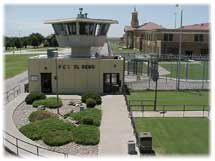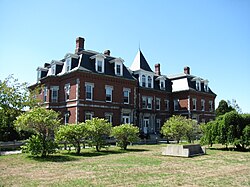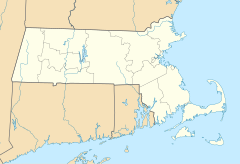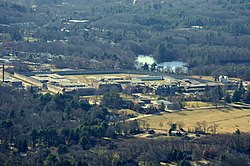
The Long Bay Correctional Complex, commonly called Long Bay, is a correctional facility comprising a heritage-listed maximum and minimum security prison for males and females and a hospital to treat prisoners, psychiatric cases and remandees, located in Malabar, Sydney, New South Wales, Australia. The complex is located approximately 14 kilometres (8.7 mi) south of the Sydney CBD and is contained within a 32-hectare (79-acre) site. The facility is operated by Corrective Services New South Wales, a department administered by the Government of New South Wales.
Elmira Correctional Facility, also known as "The Hill", is a maximum security state prison located in Chemung County, in the City of Elmira in the US state of New York. It is operated by the New York State Department of Corrections and Community Supervision. A supermax prison, Southport Correctional Facility, is located 2 miles (3.2 km) away from Elmira.
Massachusetts Correctional Institution – Shirley is a medium-security state prison in Shirley, Massachusetts. The facility also contains a minimum-security section which houses less dangerous prisoners. MCI-Shirley maintains 13 inmate housing units, a 28-bed full-service hospital unit, a 59-bed segregation unit, gym, recreation areas, school, industries, laundry, vocational area, and food services/programs. This facility is under the jurisdiction of the Massachusetts Department of Correction. It is located directly to the north of the Souza-Baranowski Correctional Center, a maximum-security facility in the town of Lancaster. On January 6, 2020 there was 992 Medium and 269 minimum inmates in general population beds.
Pontiac Correctional Center, established in June 1871, is an Illinois Department of Corrections maximum security prison for adult males in Pontiac, Illinois. The prison also has a medium security unit that houses medium to minimum security inmates and is classified as Level 3. Until the 2011 abolition of the death penalty in Illinois, the prison housed male death row inmates, but had no execution chamber. Inmates were executed at the Tamms Correctional Center. Although the capacity of the prison is 2172, it has an average daily population of approximately 2000 inmates.
Great Meadow Correctional Facility is a maximum security prison in New York State in the United States. The prison is in Comstock, a hamlet right outside of the village of Fort Ann in Washington County, New York. As of September 3, 2008 it was home to 1,663 inmates. When Great Meadow opened in 1911 it was the fourth prison for adult males constructed in the state of New York.
Massachusetts Correctional Institution – Framingham (MCI-Framingham) is the Massachusetts Department of Correction's institution for female offenders. It is located in Framingham, Massachusetts, a city located midway between Worcester and Boston. The prison was once known as "Framingham State Prison". However, MCI-Framingham is its official name and is favored. As of May 2022 there are approximately 190 inmates in general population beds.
The Massachusetts Correctional Institution—Cedar Junction, formerly known as MCI-Walpole, is a maximum security prison under the jurisdiction of the Massachusetts Department of Correction. It was opened in 1956 to replace Charlestown State Prison, the oldest prison in the nation at that time. MCI-Cedar Junction is one of two maximum security prisons for male offenders in the Commonwealth of Massachusetts. As of January 6, 2020 there was 346 Maximum and 65 Medium inmates in general population beds.
The Pendleton Correctional Facility, formerly known as the Indiana Reformatory, is a state prison located in Fall Creek Township, Madison County, near Pendleton and about 25 miles (40 km) northeast of Indianapolis. Established in 1923, it was built to replace the Indiana State Reformatory located in Jeffersonville after a fire severely damaged the original property. The Pendleton facility currently offers maximum and minimum-security housing for adult males over 22 years old. The maximum-security portion is made up of 31 acres (130,000 m2) surrounded by a concrete wall. It has an average daily population of approximately 1,650 inmates. Located on the grounds outside the enclosure, the minimum-security dormitory holds approximately 200 prisoners on a daily basis.

The Indiana Women's Prison was established in 1873 as the first adult female correctional facility in the country. The original location of the prison was one mile (1.6 km) east of downtown Indianapolis. It has since moved to 2596 Girls School Road, former location of the Indianapolis Juvenile Correctional Facility. As of 2005, it had an average daily population of 420 inmates, most of whom are members of special-needs populations, such as geriatric, mentally ill, pregnant, and juveniles sentenced as adults. By the end of 2015, the population increased to 599 inmates. Security levels range from medium to maximum. The prison holds Indiana's only death row for women; however, it currently has no death row inmates. The one woman under an Indiana death sentence, Debra Denise Brown, had her sentence commuted to 140 years imprisonment in 2018 and is being held in Ohio.

The Monroe Correctional Complex is a Washington State Department of Corrections men's prison located in Monroe, Washington, United States. With a bed capacity of over 3,100, it is the second largest prison in the state.

The Massachusetts Department of Correction is the government agency responsible for operating the prison system of the Commonwealth of Massachusetts in the United States. The Massachusetts Department of Correction is responsible for the custody of about 8,292 prisoners throughout 16 correctional facilities and is the 5th largest state agency in the state of Massachusetts, employing over 4,800 people. The Massachusetts Department of Correction also has a fugitive apprehension unit, a gang intelligence unit, a K9 Unit, a Special Reaction Team (SRT), and a Tactical Response Team (TRT). Both of these tactical units are highly trained and are paramilitary in nature. The agency is headquartered in Milford, Massachusetts and currently headed by Commissioner Carol Mici.

California Correctional Institution (CCI) is a supermax state prison in the city of Tehachapi in southern California. CCI is sometimes referred to as "Tehachapi prison" or "Tehachapi". As stated by the California Department of Corrections and Rehabilitation, its overall mission is "to incarcerate and control felons, while providing the opportunity for meaningful work, training and other programs. The prison provides programs for those inmates who are willing to work and participate fully in available programs."

Michigan State Prison or Jackson State Prison, which opened in 1839, was the first prison in Michigan. After 150 years, the prison was divided, starting in 1988, into four distinct prisons, still in Jackson: the Parnall Correctional Facility which is a minimum-security prison; the G. Robert Cotton Correctional Facility where prisoners can finish their general education; the Charles Egeler Reception and Guidance Center which is the common point of processing for all male state prisoners sentenced to any Michigan prison; and the Cooper Street Correctional Facility which is the common point for processing of all male state prisoners about to discharge, parole, or enter a community center or the camp program.
The Indianapolis Juvenile Correctional Facility was a minimum, medium, and maximum state juvenile facility of the Indiana Department of Correction. It was located on Girls School Road, 8 miles (13 km) west of downtown Indianapolis. The facility currently houses 185 female inmates ranging in age from twelve years to twenty-one years. The facility was originally established in 1907 as an all-girls school and was known for most of its history as the Indiana Girls School. In 2006, juvenile male offenders were assigned to the facility as well. In late 2007 all male offenders were transferred to other state facilities and the Indianapolis Juvenile Correctional Facility reverted to being an all female facility. In 2009 the girls were moved to the Madison Juvenile Correctional Facility, and the former IJCF became the current location of the Indiana Women's Prison.

The Union Correctional Institution, formerly referred to as Florida State Prison, Raiford Prison and State Prison Farm is a Florida Department of Corrections state prison located in unincorporated Union County, Florida, near Raiford.

Federal Correctional Institution, El Reno is a medium-security United States federal prison for male inmates in Oklahoma. It is operated by the Federal Bureau of Prisons (BOP), a division of the United States Department of Justice. The facility has an adjacent satellite camp for minimum-security male offenders.

Charlestown State Prison was a correctional facility in Charlestown, Boston, Massachusetts operated by the Massachusetts Department of Correction. The facility was built at Lynde's Point, now at the intersection of Austin Street and New Rutherford Avenue, and in proximity to the Boston and Maine Railroad tracks that intersected with the Eastern Freight Railroad tracks. Bunker Hill Community College occupies the site that the prison once occupied.
Arizona State Prison – Kingman is a privately run minimum/medium-security prison designed to hold 3500 prisoners. It is located in unincorporated Mohave County, Arizona, in Golden Valley. When the idea of the prison was being sold to the residents of Golden Valley it was promised that it would be a prison only for Dui offenders. It was operated by the Management and Training Corporation under contract to the Arizona Department of Corrections until August 2015. MTC had been criticized for allowing the homicidal escape of three violent prisoners in 2010. The state began seeking an alternate provider after it found MTC failed to control riots on July 1, 2 and 4, at Kingman, in July 2015.

North Carolina Correctional Institution for Women (NCCIW) is the primary North Carolina Department of Public Safety prison facility housing female inmates on a 30-acre (12 ha) campus in Raleigh, North Carolina, and serves as a support facility for the six other women's prisons throughout the state. The facility's inmate population, which is the largest in the state, consists of inmates from all custody levels and control statuses including death row, maximum security, close custody, medium security, minimum security, and safekeepers.
North Fork Correctional Center is a medium to maximum security correctional facility for men located east of Sayre, Beckham County, Oklahoma.












